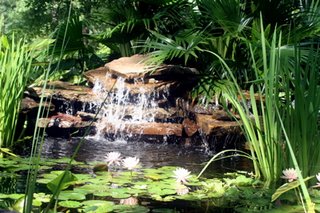When it is cold outside, we often need to net just one fish out of the water and no matter how hard we try we can't do it. We often end up cold and wet and covered with pond scum because we tried so hard to reach just a little bit farther. Why on earth would we need to know how to get fish out of the pond? Sometimes fish have some sort of disease and treating the entire pond is almost impossible, but treating a few sick fish is economically feasible.
Pour warm water into one end of the pond. The fish will come toward the warm water and right into the net you have conveniently placed there.
Time to time musings about backyard garden pond building, keeping, troubleshooting. Questions and answers from pond keepers and builders. Occasional excerpts from the pondlady's book, "A Practical Guide to Building and Maintaining your Pond."
Friday, September 08, 2006
Thursday, September 07, 2006
Pump use
Question:
I have heard that a pump will keep the water clear. How big should my pump be? Must it run all the time?
Pondlady sez:
A pump will never keep the water clear. A pump moves water and provides oxygen for the fish if you feed them and the pond is overpopulated. If you have a natural ecosystem there will be no overpopulation and therefore you will not need any pump if you don't wish to have one. Most folks like them because we all like the sound of moving water and waterfalls.
You ned a pump that circulates all the water once per hour. Most people run the pump all the time, but it is not necessary at all. You can run the pump on a timer or when you are outside to enjoy your waterfall.
No pump has to be turned on all the time unless you feed your fish or have koi.
And if you live in a climate where you have freezing weather, turn the pump off in the winter. Most pumps do not function well in freezing water. If you are worried about your pond freezing over, throw an empty plastic gallon jug or several in the water during the freezing weather. In the morning, remove the jug and there will be a hole in the ice so gases can move freely during the day. Be sure to put that jug back in the water when the freezing weather returns at night.
I have heard that a pump will keep the water clear. How big should my pump be? Must it run all the time?
Pondlady sez:
A pump will never keep the water clear. A pump moves water and provides oxygen for the fish if you feed them and the pond is overpopulated. If you have a natural ecosystem there will be no overpopulation and therefore you will not need any pump if you don't wish to have one. Most folks like them because we all like the sound of moving water and waterfalls.
You ned a pump that circulates all the water once per hour. Most people run the pump all the time, but it is not necessary at all. You can run the pump on a timer or when you are outside to enjoy your waterfall.
No pump has to be turned on all the time unless you feed your fish or have koi.
And if you live in a climate where you have freezing weather, turn the pump off in the winter. Most pumps do not function well in freezing water. If you are worried about your pond freezing over, throw an empty plastic gallon jug or several in the water during the freezing weather. In the morning, remove the jug and there will be a hole in the ice so gases can move freely during the day. Be sure to put that jug back in the water when the freezing weather returns at night.
Wednesday, September 06, 2006
More aquatic plants
I want to spend more time with submerged plants. They are the engine that makes the pond run properly. After submerged plants, I will talk about floating plants, marginals and emergents.
Submerged aquatics generally grow completely submerged. They are sometimes rooted in the pond bottom and sometimes float freely.
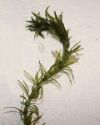
This is the anacharis or elodea we talked about yesterday. It is the most popular and widely used. It is invasive, but not as bad as hydrilla.
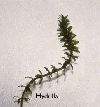 This is hydrilla, another underwater grass.
This is hydrilla, another underwater grass.
They look much alike, but if hydrilla is allowed loose in any fresh water anywhere, it will become a nuisance that will have to be dealt with by governmental authorities. If you see any anywhere for sale, please do not buy it.
Submerged aquatics generally grow completely submerged. They are sometimes rooted in the pond bottom and sometimes float freely.

This is the anacharis or elodea we talked about yesterday. It is the most popular and widely used. It is invasive, but not as bad as hydrilla.
 This is hydrilla, another underwater grass.
This is hydrilla, another underwater grass.They look much alike, but if hydrilla is allowed loose in any fresh water anywhere, it will become a nuisance that will have to be dealt with by governmental authorities. If you see any anywhere for sale, please do not buy it.
Tuesday, September 05, 2006
Anacharis
We talk about needing submerged vegetation in almost every post, so let's see what it looks like:

Elodea canadensis, sometimes called Anacharis (a former scientific name) is widely known as the generic pond submerged vegetation.
In Louisiana we use primarily anacharis for our submerged vegetation. It filters the water, it survives on fish waste and it serves as fish food. Anacharis is the reason we do not need to feed our fish and the reason the water stays clear with no artificial filtration.
Elodea (anacharis) is native to North America and is banned in some states because of it's invasiveness.
The American anacharis lives entirely underwater with the exception of small white flowers which bloom at the surface and and look like somebody threw popcorn all over your pond.
It likes to have some shade and will turn yellow and die when in complete sun.
Please use anacharis responsibly. When you have too much, just compost it, do not throw it in any nearby body of water.

Elodea canadensis, sometimes called Anacharis (a former scientific name) is widely known as the generic pond submerged vegetation.
In Louisiana we use primarily anacharis for our submerged vegetation. It filters the water, it survives on fish waste and it serves as fish food. Anacharis is the reason we do not need to feed our fish and the reason the water stays clear with no artificial filtration.
Elodea (anacharis) is native to North America and is banned in some states because of it's invasiveness.
The American anacharis lives entirely underwater with the exception of small white flowers which bloom at the surface and and look like somebody threw popcorn all over your pond.
It likes to have some shade and will turn yellow and die when in complete sun.
Please use anacharis responsibly. When you have too much, just compost it, do not throw it in any nearby body of water.
Monday, September 04, 2006
Enlarging your pond

One pond regret most people have is they made their first pond too small. So they now want a bigger one.
If you must make the pond bigger, get a new liner. Don't try buying another piece of liner and attaching it to the first piece. You cannot seam a liner successfully in the field. You just can't, so don't get frustrated AND lose money by trying. My method of dealing with the client who wants a larger pond after building the first one is to install a second pond abutting it with a rock wall between the two. I reinforce the walls with 28 or thicker 14” roofing flashing staked up with 1/2” PVC pipe. Doing that insures no collapse of the dividing pond side. Each pond has it’s own pump, it’s own liner, plants, fish etc. Our eyes are fooled because it looks as if there is just a wonderful bridge over the pond when indeed the ‘bridge’ is a divider between two ponds.
Sunday, September 03, 2006
Good morning
Saturday, September 02, 2006
Fish eating critters
Here in New Orleans, lots of critters eat our fish. Raccoons, egrets, herons, cranes all tear through our ponds, eating fish and having a water lily salad with their sushi. As much as we might want to shoot egrets after losing a prize koi or goldfish, it is illegal. It does, however, seem to be perfectly OK to shoot humans and we do it daily, reducing the human population by at least one daily. But I digress.
Years ago, a client of mine was at his wit's end. Egrets were dining daily on his goldfish. This man was a sensible, middle aged guy, a successful and caring OB/GYN who cured, not harmed living things. But he had had it. One day, he got a shotgun and shot at the egrets while they were enjoying dinner. He missed the egrets. But he did manage to puncture his liner, mangle his lawn furniture and his neighbors fence. Luckily he was not caught by the local law enforcers; I don't think they would have understood.
Soon after, I talked him into Gator Guard, a pretty effective way of scaring birds and other critters away.
Years ago, a client of mine was at his wit's end. Egrets were dining daily on his goldfish. This man was a sensible, middle aged guy, a successful and caring OB/GYN who cured, not harmed living things. But he had had it. One day, he got a shotgun and shot at the egrets while they were enjoying dinner. He missed the egrets. But he did manage to puncture his liner, mangle his lawn furniture and his neighbors fence. Luckily he was not caught by the local law enforcers; I don't think they would have understood.
Soon after, I talked him into Gator Guard, a pretty effective way of scaring birds and other critters away.
Friday, September 01, 2006
Bottom rocks
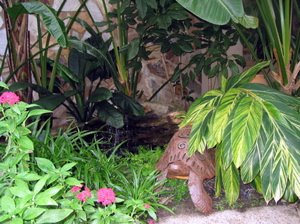
Many folks and one large pond building franchise advocate covering the bottom of the pond with rocks. I think they do this for two reasons. 1) They can charge much more money to build the pond and to clean the pond yearly, and 2) Some really believe that it will help the ecosystem. During my eighteen years of pond building, I never put rocks on pond bottoms, and in all of the ponds I built and maintained, I never, not one time, had green water.
Each and every time I saw a pond bottom covered with rocks, I groaned because I knew that I had to charge the customer much more money to shovel those stones off the bottom to clean the pond. I usually talked them into not replacing them with the promise that next year's cleaning would cost about half as much - because it took half the time and work.
If you think rocks look nice and don't mind the extra cost of cleaning or the extra work of doing it yourself, by all means put them there. But trust me, you do not need them.
Thursday, August 31, 2006
Ponds in the shade
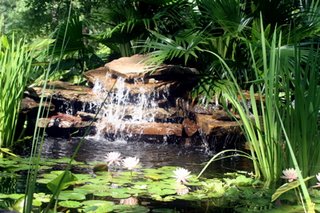
Putting a pond in the shade means you give up water lilies, but you get to plant so many lovely plants around the pond and in the water.
Try Taro (A large elephant ear like plant, but very tropical), or Umbrella plant. I think that it will grow anywhere you put it. As an aside, be very careful if you live in the subtropics, do not plant them close to your house in the ground. I had to break the bad news to a homeowner that the umbrella plant she had lovingly put next to her sunroom had broken the foundation of her house. You may also want to try some indoor plants and take them in during cold weather. Any of the spaths love to have their feet wet and all of the philodrendons.
Some shade tolerating water lilies have been developed. Check your local aquatic nursery for availability and hardiness in your area.
Around the pond you can plant ferns of any and all kinds, gingers and Chinese Fan Palms can back up the waterfall.
Wednesday, August 30, 2006
Leaking liner?
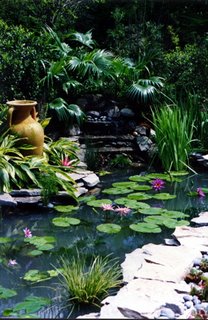
Finding the leak:
Chances are your liner is not leaking at all if you are losing water. Evaporation is usually the cause of slowly lowering water levels. If the water level falls significantly overnight, you are most probably losing it because water is falling off the back of a waterfall or if you have a fountain, the wind has blown the water out of the pond. Or if the water is falling from too far up, it is splashing out. Check all of these things before you suspect a leak in your flexible liner.
If you have finally determined that your liner is leaking, your biggest problem is finding the leak.
Most liners have some sort of patching material, much like patching a tire, but until you find the leak, you cannot patch it. I have found that pumping the water out of the pond and then running water under the liner is the best way to find that ‘unfindable’ leak. Here in New Orleans, the water will come up through the hole when I get water under the liner. I know it is a pain in the neck, but I have yet to find a better way.
At least when you have found the leak, the patching of it is a piece of cake.
Tuesday, August 29, 2006
Questions and a great hummer
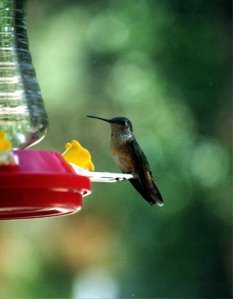
Dear Jan,
I live in Memphis, TN. I am considering putting a
pond in my back yard---possibly this weekend if I get real energetic!!!!!
My question is this, my neighbors across the street purchased a preformed
pond, another friend of mine has a liner type---do you know if one is better
than the other? Also, my backyard slopes from my back porch down to the
fence, I was wondering if this could also pose a problem--I was considering
placing what I would call the "top" of the pond at the top of the slope---please help--don't want to make any major mistakes.
Pondlady sez:
Use a liner!!! A preformed pond is a major hassle and will
never look right. You cannot get it level...ever, so the top will always show. Even if it is level for a moment, leave it alone and it will shift out of level. And it is more expensive in the long run.
Having your pond on a slope is a great idea. Remember you will not have to dig as deep, if at all, depending on the angel of the slope, on the higher end of the slope and you will have to pile up more rocks on the lower end to make the pond level.
That way the pond is level and liner doesn't show anywhere.
Don't forget that water is ALWAYS level. Although we are short on sloping ground in New Orleans, I, occasionally, have found some and a pond build on a slope looks great.
Monday, August 28, 2006
Questions to the Pondlady
We have recently put a pond in our back yard, a fairly large one! We
did this because our older son loves to play with all kinds of critters
(Water or Land). At first we had a crystal clear pond, that is, liner,
rocks, water, pump, and filter. Once we put the plants and fish in, what a
green soupy mess in a matter of days. I got information from our local nursery
and he recommended a powder to clear the water. I am reading your page
and you say no chemicals. Well I don't know if the chemical worked or if
I got enough information off line about plants and fish and got lucky and
combined a good combo. Now this guy is recommending a UV light to keep
the water clear- What do you think? Also you say no turtles because
they will eat the fish ---oh no!!! My son is putting turtles in on a
daily basis and we do have a missing fish. I can't understand why it
would have eaten a large fish and not the baby ones. Is there any way
to have the turtles and fish? Maybe if we keep minnows in the pond. Any
advice would be appreciated, I want to have a pond that is clear and
enjoyable with great color. Any opinions on goldfish(fantail)? Thanks
for listening and I hope to hear from you at your convenience.
PL answers: Wow, lots of questions. First of all, you are on the right track. As far as the UV goes, I have installed them, but if we keep our ponds balanced, we don't need them at all and it is just one more than that needs to be watched and replaced. The turtles will eventually eat the plant material, probably much faster than the fish. My guess on the missing fish is that a visiting bird had a great sushi dinner that night.
Minnows are great. They will keep the mosquito population away, although your pump will do that just fine. Mosquitoes will not breed in moving water.
A fan tail goldfish will be great. I would wait until the pond is a few months old before introducing any expensive fish. I also advise against feeder fish because many of them are sick when you buy them. After all, they are used only for feeding larger fish. If they are sick, sometimes they can introduce a disease to the other fish and you will lose them all.
You seem to be doing fine. Just remember, a pond thrives on benevolent neglect.
Have fun and don't name those fish.
did this because our older son loves to play with all kinds of critters
(Water or Land). At first we had a crystal clear pond, that is, liner,
rocks, water, pump, and filter. Once we put the plants and fish in, what a
green soupy mess in a matter of days. I got information from our local nursery
and he recommended a powder to clear the water. I am reading your page
and you say no chemicals. Well I don't know if the chemical worked or if
I got enough information off line about plants and fish and got lucky and
combined a good combo. Now this guy is recommending a UV light to keep
the water clear- What do you think? Also you say no turtles because
they will eat the fish ---oh no!!! My son is putting turtles in on a
daily basis and we do have a missing fish. I can't understand why it
would have eaten a large fish and not the baby ones. Is there any way
to have the turtles and fish? Maybe if we keep minnows in the pond. Any
advice would be appreciated, I want to have a pond that is clear and
enjoyable with great color. Any opinions on goldfish(fantail)? Thanks
for listening and I hope to hear from you at your convenience.
PL answers: Wow, lots of questions. First of all, you are on the right track. As far as the UV goes, I have installed them, but if we keep our ponds balanced, we don't need them at all and it is just one more than that needs to be watched and replaced. The turtles will eventually eat the plant material, probably much faster than the fish. My guess on the missing fish is that a visiting bird had a great sushi dinner that night.
Minnows are great. They will keep the mosquito population away, although your pump will do that just fine. Mosquitoes will not breed in moving water.
A fan tail goldfish will be great. I would wait until the pond is a few months old before introducing any expensive fish. I also advise against feeder fish because many of them are sick when you buy them. After all, they are used only for feeding larger fish. If they are sick, sometimes they can introduce a disease to the other fish and you will lose them all.
You seem to be doing fine. Just remember, a pond thrives on benevolent neglect.
Have fun and don't name those fish.
Sunday, August 27, 2006
Liners and leaks

Liners and leaks
I get many dozens of calls and e-mails yearly from folks who are panicked because they think their liner is leaking. Perhaps 1% of those calls are truly liner punctures or tears. And that can usually be traced to the family dog or a neighborhood raccoon. The rest of the time, the losing of water can be attributed to other things. The biggest culprit is the waterfall. Even if we start with a waterfall where all of the water being pumped over it is falling into the pond, invariably there is some settling of the rocks because of all that weight on the ground and a few drops of that waterfall water can sneak right off the back or the side of the fall. If you are losing water, turn the pump off, fill the pond up and watch it for 24 hours. If no water is lost, you know that somewhere between the pump and the waterfall your water is leaking out. A second culprit is wind. Some of you have fountains or water features that spray out water. If there is a wind and the fountain is turned on, water will blow out causing a drop in the water level of the pond. Probably one of the other main causes of water loss is splashing. The width of the water must be twice as wide as the water drop is high, eg. If the pond is 3’ wide, the water cannot drop from more than a height of 1.5 feet. If it does, no matter how slowly it drops (And I have seen it regulated to a trickle), some water will splash out. It only takes a few drops and the water level drops significantly.
If the pump is attached to plumbing fittings, check all of those fittings for leaks before calling for help. If the liner is penetrated in any way, with a skimmer device, an electrical connection, an overflow or level regulator, check those penetrations. No matter how good the caulking job was, sooner or later the seal will break and you will lose water. I recommend never penetration the side or bottom of the liner, no matter if it is flexible or rigid plastic, concrete or gunnite or CIM. No matter what, you can conceal the wires that must run from the pump more easily than you can make the inevitable repairs.
While I am on the subject of liners, I always choose flexible plastic or rubber. It is easier and lasts longer. Concrete always cracks. Yes, always!! The preformed shells can never be level, but even if they are leveled for a minute or so, they will be out of level shortly and will drive you nuts trying to keep the liner from showing. And if you are using a flexible liner NEVER try to attach two pieces together. Many folks try; no one has ever succeeded. If you wish to have an oversized piece, the manufacturer will happily seam two pieces together free of charge before they ship it to you.
Friday, August 25, 2006
Summer in the City
It’s summer in New Orleans. And that means it’s hot. And the humidity is so high, you need gills to breathe. While tending an Oriental Garden that I have tended since 1989, I find a peace that smoothes all of the rough edges of life. I feel and smell rain coming. I know that I will not finish my work in the garden. But the plants need to be washed; so does the air around them. As the wind signals the rain’s approach, the temperature drops. I lay on the dense pennyroyal that I use as a ground cover and close my eyes to feel the weather change. The smell of the pennyroyal promises excitement and newness. First, I feel the barometric pressure dropping, it allows me to be lighter, to feel the air changing around me. And then the smells of change start. I can smell the Gulf of Mexico flying in on hummingbird wings, the salt settles on my skin, I can taste it on my lips. I can smell a fishy smell, a smell of sea creatures older than time. As I let myself ride on the wind, I can sense a communion with the water that is riding in on southern clouds. I can feel the air that had been over South America a short time ago, reaching New Orleans and bathing me in foreign connections and somehow they did not feel foreign at all. I can smell the oneness that the wind brought with it. I can hear it whisper, no, not whisper, more like insistently talk to me--”We are one, we bring you pieces of yourself that you have scattered in the past. We bring you back to yourself.” When the first giant drops splash on my forehead, I feel refreshed. I wonder if I might stay in the pennyroyal, being massaged by its leaves, its scent being released by my weight and the rain while it drank in water. It welcomes me, asks me to enjoy the rain with it and I quietly breathe thanks. The rain is brief, about 20 minutes or so--like so many summer showers here. The air is clean afterward, the garden is bright, I dry quickly while watching the steam rising from the boulders so carefully placed as to look natural. All of our senses are tingling--mine and the plants together, a communion of trust, beauty and peace.
Once again the garden refreshes my spirit and tells me of my place in the world.
Once again the garden refreshes my spirit and tells me of my place in the world.
Thursday, August 24, 2006
A guest blogger today
MIchael Spencer is a landscape architect in Florida and several days ago we learned that selling goldfish and koi is illegal in Maine; that discussion led to several comments of which this is one.
I think I might come down on the other side on this discussion about legal goldfish- reluctantly- and here is why: yesterday I saw an escaped Iguana crossing the road. He was a beautiful creature, sure, about 3' long, maybe 6" at the crest of his head. In some places around here they have reached 6' long and are eating turtles [traditional alligator food], ducks [same], and dogs and cats. Seriously. There is now a marine version living on the barrier islands that gets even larger and is breeding unchecked with no predators.
And everywhere I look, we are inundated by Australian pine, Brazilan pepper, and maleleuca [another Australian import from the 1900's designed to 'dry up the everglades'!]. These trees have a devastating effect on the local flora. And they are only the largest examples.
Our lakes are full of a fish called Tillapia, a fish served in restaurants, originally from South America, and now rapidly displacing bass [so you can see this really makes some people mad]. It is moved from lake to lake by birds, where eggs attach to legs.
It is true that Florida's benign environment attracts lots of immigrants. But it is also true that every clime in the US shares the same basic climate with areas of the earth that are many hundreds of times larger and that teem with plants and animals unique locally and a hazard when introduced.
In the ornamental plant world, great care is taken with propagation. In the case of desirable plants that cannot be made sterile, they are simply made unavailable by the commercial growers. We used to use a plant on the beach [Scaevola] that was beautiful and easy to propagate. But it shaded out the natural beach plants and then we suffered dune damage. Now, that plant is not available.
Can Koi survive in the wilds of Maine? Sure. They live outside in Japan, right? And in Maine? And even if a few die, many will survive. Goldfish, I dunno. We don't have any ordinances on these fishes here in Florida and I wonder why.
So the best thing for all of us- all of us who are nature lovers- is to behave responsibly. And realize that the water you toss out just might contain eggs.
–ms
I think I might come down on the other side on this discussion about legal goldfish- reluctantly- and here is why: yesterday I saw an escaped Iguana crossing the road. He was a beautiful creature, sure, about 3' long, maybe 6" at the crest of his head. In some places around here they have reached 6' long and are eating turtles [traditional alligator food], ducks [same], and dogs and cats. Seriously. There is now a marine version living on the barrier islands that gets even larger and is breeding unchecked with no predators.
And everywhere I look, we are inundated by Australian pine, Brazilan pepper, and maleleuca [another Australian import from the 1900's designed to 'dry up the everglades'!]. These trees have a devastating effect on the local flora. And they are only the largest examples.
Our lakes are full of a fish called Tillapia, a fish served in restaurants, originally from South America, and now rapidly displacing bass [so you can see this really makes some people mad]. It is moved from lake to lake by birds, where eggs attach to legs.
It is true that Florida's benign environment attracts lots of immigrants. But it is also true that every clime in the US shares the same basic climate with areas of the earth that are many hundreds of times larger and that teem with plants and animals unique locally and a hazard when introduced.
In the ornamental plant world, great care is taken with propagation. In the case of desirable plants that cannot be made sterile, they are simply made unavailable by the commercial growers. We used to use a plant on the beach [Scaevola] that was beautiful and easy to propagate. But it shaded out the natural beach plants and then we suffered dune damage. Now, that plant is not available.
Can Koi survive in the wilds of Maine? Sure. They live outside in Japan, right? And in Maine? And even if a few die, many will survive. Goldfish, I dunno. We don't have any ordinances on these fishes here in Florida and I wonder why.
So the best thing for all of us- all of us who are nature lovers- is to behave responsibly. And realize that the water you toss out just might contain eggs.
–ms
Wednesday, August 23, 2006
Plants and Fish
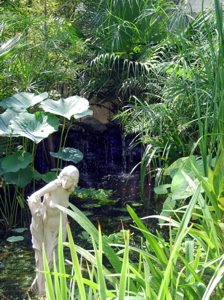
For a garden pond to be successful, it must contain both plants and fish. Not only is this an optimum esthetic condition; but a balanced biotope with interactions between plants and fish will ensure proper water conditions, reduce insects, especially mosquitos, since the fish consume their larva, and plants will greatly reduce the development of algae.
Plants and fish benefit each other in two ways. First, fish and plants contribute to the successful functioning of the nitrogen cycle. As the waste products excreted by fish are released into the water, they are converted to ammonia and then to nitrites and nitrates by nitrifying bacteria. Nitrates are a food or fertilizer for plants and algae. As they are absorbed, plants and algae become a valuable food resource for fish, thus completing the nitrogen cycle.
This ongoing biological cycle ensures healthy pond life. It is important to realize that if plants are not thriving, algae will take over and the water will become murky.
A second important way fish and plants complement one other is through the process of photosynthesis. Fish require oxygen for their existence and they release carbon dioxide. Plants in turn require carbon dioxide for their successful existence and emit oxygen. During sunlight, plants will consume the carbon dioxide released by fish and in turn emit oxygen required by fish.
A constantly functioning nitrogen cycle and photosynthesis are the key components to a successful and beautiful garden pond. The most beautiful type of pond plants are lilies. Water lettuce and water hyacinths are also excellent additions to the pond and submerged plants such as Hornwort, Vallisneria, Sagitarria, Cabomba and Anacharis are also excellent. The ideal pond fish are common or hardy goldfish.
Tuesday, August 22, 2006
Rich Sacher, a guest blogger

Tropical Water Lilies
by Rich Sacher, Owner, American Aquatic Gardens, New Orleans, La
(Zone 9 Directions)
Tropical water lilies are very easy to grow and their blooming season in New Orleans is from May 1st until a killing frost in December. They come in a wide variety of colors, including some varieties which bloom at night. A well-grown plant will have several flowers open every day of its eight month blooming season, and each flower lasts three days.
•Sunlight
Water lilies must have a minimum of five hours of direct sunlight in order to bloom heavily; the more sun, the better.
•Water
Water lilies requre a minimum of six inches of water over the soil level in the pot; larger lilies can take 8 to 10 inches depth of water. Water does not have to be circulated and quiet fountains will not harm the waterlilies.
•Soil
Any heavy garden soil is suitable, but no peat moss, bark or other floating materials should be used.
•Fish
If you have fish in your pond, cover the soil of your waterlily pot with heavy pieces of broken slate, sand or pea gravel so fish cannot dig up the plants.
•Algae
Green water is often a problem in full sun and well fertilized plants; do not use chemicals to control the algae--it will kill your lilies. Instead, encourage a healthy growth of submerged plants like anacharis one bunch per square foot of surface area, which will help starve out the algae. Some floating hyacinths or water lettuce will also help, but watch they do not get out of control.
•Chores
To keep the pond looking good, remove yellowing leaves and spent flowers every week. If an individual lily spreads too much, you can remove the outer ring of leaves to reduce the overall size of the plant without affecting flowering. If aphids appear, hose them into the water each morning to provide food for your fish. Caterpillars can be picked off by hand.
•Treating for Aphid Infestation
The following technique can be used to treat water lilies for aphid infestation without harm to your fish. Aphids and many other garden pests can be easily controlled with an inexpensive, homemade insecticide--according to the U.S. Department of Agriculture.
This recipe was developed after entomologists at the Agriculture Research Center in Phoenix, Arizona, discovered that a spray of soybean oil protected cotton from aphids and whiteflies. Home gardeners should mix one tablespoon of dishwashing detergent with one cup of cooking oil. When pests strike, mix one to two and one half teaspoons of the detergent oil mix with one cup of water. The detergent causes the oil to emulsify in the water. It can be sprayed on the water lilies every ten days. Besides aphids, the mixture works against whiteflies and spider mites. It has been successfully tested on eggplants, carrots, lettuce, celery, watermelon, peppers and cucumbers. It tends to burn the leaves of squash, cauliflower and red cabbage.
•Over-wintering Tropical Water Lilies
Tropical water lilies are perennial by nature, and they will go dormant as the weather becomes cold and days grow shorter. In New Orleans, they will often bloom until mid to late December, at which time the plants are already becoming smaller and slow growing.
You should stop fertilizing the lilies is mid October, because by starving the plants at the end of the season, they are more likely to form some small, very hard and durable tubers which survive the dormant period much better than the large fleshy root of the main plant.
These small tubers can be broken off from the parent plant and rinsed clean of soil; they should be stored in damp sand for the winter at a temperature of 50 to 55 degrees. These tubers can be planted out in the pond in mid-April, when they will begin to sprout new leaves by the middle of May. (Plant them in rich or fertilized soil, one half inch below the soil surface, and place them in a shallow area of the pond with 2 to 4 inches of water over the pot.)
If you have a greenhouse, you should move your waterlily to a small tub or temporary pond inside. In this case, do not disturb the roots; allow the plant to continue growing until it becomes dormant and leave it in the pond until new leaves come up again the spring. Once the plant is growing again, it can be divided if necessary and repotted in fresh solid for the growing season. This method almost always ensures the survival of the plant if the temperature never goes below 55 degrees in your greenhouse.
Those persons who are fortunate enough to have a large natural pond will find that just leaving the lily in the pond through the winter is the best method; this is especially true if the pond is fed by artesian wells, where the water temperature stays above 50 degrees no matter how cold the winter nights might be. This allows the plant to go dormant, but the temperature is warm enough to prevent damage to the tubers.
If the water temperature of your pond goes below 45 degrees for a number of days during the winter, then you will need to move the plant or tubers indoors for the dormant season, because temperatures below 50 degrees may result in the death of the tubers.
Since winters in New Orleans are so unpredictable, I would guess that most people would have about a 50 percent success rate if they just let their lilies in their ponds through the winter. The determining factor is temperature; how cold does it get and how long does it stay cold.
So if you enjoy a challenge, try one of these methods of over-wintering your lilies. Or, if you want to be more laid back about it, you can do nothing at all and take a chance on Mother Nature. You should win about half the time.
Monday, August 21, 2006
Do I need a filter?
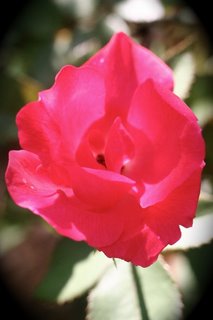
I know a knock out rose has nothing to do with filtration, but it was so pretty in my garden this morning, I wanted to share.
If you have Koi or if you feed your goldfish, you MUST have filtration of some sort. There are many filters on the market from a plain sponge type to biofilters with UV lights. I have used them all and find that the very best is a biofilter installed outside the pond with a UV light installed in conjunction with it. (A UV light is not effective with blanketweed or String Algae.) So if you are going to feed those fish or have Koi, think about using this filter. The downside of these bead filters is the cost. They can run to $4000.00 with the flick of a fish's tail. There are cheaper ones that work just as well, but it's more work to keep them clean and running properly.
If you wish to build your own filter, it is quite simply using a container of some sort and filling it with some sort of filtration medium like lava rocks, sand, gravel, etc. I use the coarser material at the top of the filter (where the water goes in) and the finer material at the bottom. Much of the time lava rock or bioballs are sufficient. You must get the water into the top of the filter- pretty easy if the fliter is in the water and suck it out of the bottom with the pond pump. This can be accomplished with a simple tap that attaches to the intake of the pump. You can also just put the pump in the bottom of the container, and put the lava rocks or whatever filter media you use in a mesh bag and not have to worry about a tap of any kind. Your cost just went down to the cost of the media plus the cost of the mexh bag.
If you do not feed your fish, you need no filtration at all. BUT you must provide natural filtration. The best way I have found is to use anacharis as a submerged plant. The anacharis grows faster than the fish can eat it, so the pond becomes a natural ecosystem. And you must keep about 50-60% of the top of the pond covered with shade. You can do this with floating plants like hyacinths, water clover, water poppy, parrots feather or water lilies. If your pond is in the shade already, you do not need so many floating plants.
Many chemicals are sold that promise a clear pond if you add the chemicals. Some of the time they work. For the most part they do not. They kill algae. The dead algae sinks to the bottom where there is then no available oxygen for the other plants. They die and so do the fish because there is no oxygen for them to breathe. If you do not use chemicals, this problem can be avoided before it starts.
Sunday, August 20, 2006
Algae Bloom
An algae bloom is normal when the pond is brand new. If you are patient and the pond is properly balanced, you may not have one, but don't be dismayed if you do. If it lasts more than a week and you absolutely MUST be rid of it because your mother in law is coming to visit tomorrow, there is an emergency procedure you can do right this minute and your pond will be clear by tomorrow. This is not a permanent fixture in your pond, nor is it the universal panacea for algae, but it will get that pond clear so you can show off your brand new handiwork to your visitors.
Do not use any of the algaecides that are available commercially. Most of them severely decrease the oxygen level in the pond and that will kill the fish. Remember that anything that will kill algae will kill other plants. Fish will tolerate green water--they will not tolerate toxic (albeit clear) water. If you have consistently green water use more submerged vegetation (Anacharis) and make sure at least 50% of the water surface is covered with floating vegetation to provide shade. This floating vegetation can be water lilies, water hyacinths, water poppies, etc. And stop feeding those goldfish.
If you must get rid of your green water fast use a temporary mechanical filter. I use a large black pot that a plant has come in--10" or bigger I also put a few more holes in it than just the one on the bottom. Be sure the holes are on the bottom of the pot or whatever container you use. I put 2 inches of foam rubber in the bottom of the pot and suspend it over the surface of the water. I usually use a lawn chair or upturned 5 gallon bucket. Next I run the hose from the pump over the top of the pot so the water runs through the foam rubber. I hold it down with a brick. This makeshift filter looks awful and must be cleaned every 2 hours or so, but it will clear up your pond in a day or two for the cost of the foam rubber. You can tell when the foam rubber has to be taken out and cleaned because the water will start running over the top of the pot. The finer the foam, the more often you must clean it, but the faster your pond will get clear. You must keep an eye on this jerry-rigged set up and continue to clean the foam rubber or your pond will not clear up.
Do not use any of the algaecides that are available commercially. Most of them severely decrease the oxygen level in the pond and that will kill the fish. Remember that anything that will kill algae will kill other plants. Fish will tolerate green water--they will not tolerate toxic (albeit clear) water. If you have consistently green water use more submerged vegetation (Anacharis) and make sure at least 50% of the water surface is covered with floating vegetation to provide shade. This floating vegetation can be water lilies, water hyacinths, water poppies, etc. And stop feeding those goldfish.
If you must get rid of your green water fast use a temporary mechanical filter. I use a large black pot that a plant has come in--10" or bigger I also put a few more holes in it than just the one on the bottom. Be sure the holes are on the bottom of the pot or whatever container you use. I put 2 inches of foam rubber in the bottom of the pot and suspend it over the surface of the water. I usually use a lawn chair or upturned 5 gallon bucket. Next I run the hose from the pump over the top of the pot so the water runs through the foam rubber. I hold it down with a brick. This makeshift filter looks awful and must be cleaned every 2 hours or so, but it will clear up your pond in a day or two for the cost of the foam rubber. You can tell when the foam rubber has to be taken out and cleaned because the water will start running over the top of the pot. The finer the foam, the more often you must clean it, but the faster your pond will get clear. You must keep an eye on this jerry-rigged set up and continue to clean the foam rubber or your pond will not clear up.
Saturday, August 19, 2006
My Anacharis Keeps Dying
If you have a concrete pond that has not been properly sealed or is new, lime will leach out of the concrete. Empty the pond, scrub it with vinegar or a mild solution of muriatic acid (one part acid to 4 parts water). Refill, test the pH. (It should be around 7.0). Let the water sit for a day or two and test again. If the pH remains about 7.0, you may replace your anacharis.(Don't forget the dechlor.)
Anacharis likes to be in the shade. If it is in full sun, it may turn yellow and die. Shade the pond with floating plants and emergents. Use water hyacinths if they are legal in your state. They are legal to own, but illegal to sell in Louisiana. They were imported in 1884 to help keep the bayous clean. They do that indeed, but they now completely cover the bayous and are considered a noxious weed. So if you do use them in a tropical or subtropical climate, please throw them in a compost heap when they multiply, not in any other body of water. You can also use water lilies or any other floater that can provide shade for your pond. Some people build an arbor to keep the pond in shade for part of the day.
Make sure you have one bunch of anacharis per square foot of surface area of water. If you have less, the fish may be eating it faster than it grows. This is most important. I know anacharis is expensive, but if you buy it a little at a time, it will cost much more because you will have to keep replacing it.
Anacharis acts as filter, catching and holding suspended material in the pond. With anacharis your pond will stay balanced and crystal clear with no other filtration.
Anacharis likes to be in the shade. If it is in full sun, it may turn yellow and die. Shade the pond with floating plants and emergents. Use water hyacinths if they are legal in your state. They are legal to own, but illegal to sell in Louisiana. They were imported in 1884 to help keep the bayous clean. They do that indeed, but they now completely cover the bayous and are considered a noxious weed. So if you do use them in a tropical or subtropical climate, please throw them in a compost heap when they multiply, not in any other body of water. You can also use water lilies or any other floater that can provide shade for your pond. Some people build an arbor to keep the pond in shade for part of the day.
Make sure you have one bunch of anacharis per square foot of surface area of water. If you have less, the fish may be eating it faster than it grows. This is most important. I know anacharis is expensive, but if you buy it a little at a time, it will cost much more because you will have to keep replacing it.
Anacharis acts as filter, catching and holding suspended material in the pond. With anacharis your pond will stay balanced and crystal clear with no other filtration.
Subscribe to:
Posts (Atom)
